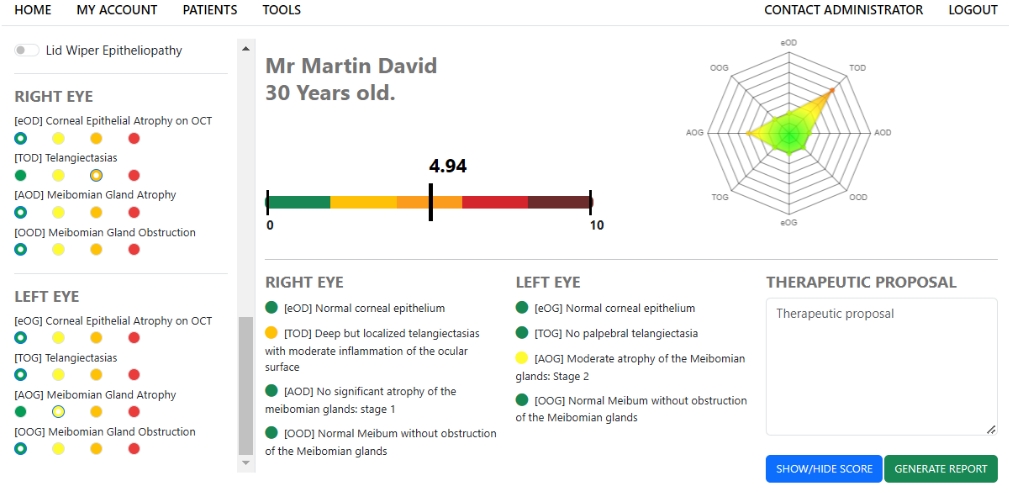OCULAR DRYNESS:
CALCULATE YOUR PATIENTS' SCORES
Introducing eTAO
Discover eTAO, the revolutionary tool for healthcare professionals specializing in dry eye. Designed to meet three essential needs:
● Efficiently structure the steps involved in modern dry eye diagnosis.
● Simplify understanding for your patients with clear, accessible elements.
● Monitor your patients’ progress accurately and continuously.
The eTAO Score is based on four fundamental clinical criteria that are well known and integrated into the dry eye examination routine. We have developed two versions to suit your needs:
● eTAO Standard: Can be used without sophisticated equipment, ideal for immediate implementation.
● eTAO Expert: For professionals with advanced machines, including additional examinations such as epithelial mapping and meibography.
With its PDF report, the eTAO application lets you communicate easily with your patients and document their cases in a professional and organized way.
Join the new generation of dry eye diagnosis and monitoring with eTAO.

e: corneal epithelium
Epithelial mapping with OCT offers an objective and precise measurement, enabling detailed characterization of corneal suffering.
Thanks to this advanced technology, you can obtain crucial information for an informed diagnosis.
No OCT?
No problem!
You can still grade the corneal epithelium using fluorescence, offering flexibility in your diagnostic tools.
With eTAO, you benefit from a comprehensive and adaptable approach to assessing and treating dry eye in your patients.
T: telangiectasias
A: Meibomian gland atrophy
Meibomian gland atrophy is a crucial piece of information for determining the stage of development of Meibomian Gland Dysfunction (MGD).
By grading this atrophy, you can follow its evolution in a precise and informed way.
With eTAO, you benefit from a sophisticated tool for monitoring and analyzing the evolution of DGM, offering your patients optimal, personalized care.
O: Meibomian gland obstruction
Epithelial mapping with OCT offers an objective and precise measurement, enabling detailed characterization of corneal suffering.
Thanks to this advanced technology, you can obtain crucial information for an informed diagnosis.
No OCT?
No problem!
You can still grade the corneal epithelium using fluorescence, offering flexibility in your diagnostic tools.
With eTAO, you benefit from a comprehensive and adaptable approach to assessing and treating dry eye in your patients.
Advantages of the eTAO application
The eTAO application is designed for all ophthalmologists to obtain a clear, precise and rapid dry eye score.
- Integrate eTAO into your surgical workup
- Track your patient's progress at a glance
- Communicating your score to your patient
- Rationalize your drought balance
- 4 essential criteria
- 2 versions: pre-op & Expert
- Less than 1 minute for calculations and editing
- Accessibility: Score hosted online
- PDF report for your patients

Simplify and secure your surgical workup with eTAO
Integrating the eTAO Score into your surgical work-up is extremely simple, and in just a few minutes provides invaluable information to help you prepare for your operation. Reassure your patient by explaining the situation clearly, and approach each subject with confidence.
Thanks to the eTAO Score, you can make targeted, personalized recommendations, ensuring optimal care.
The eTAO application is completely secure: only you receive each patient’s report and score. No personal data is stored. However, anonymized data are stored to enable meta-analyses, thus contributing to the advancement of research.
With eTAO, you can combine simplicity, safety and precision for exceptional surgical care.
Details of eTAO score criteria
The eTAO application is designed for all ophthalmologists to obtain a clear, precise and rapid dry eye score.
e: corneal epithelium
- e1: No KPS - No epithelial atrophy on OCT
- e2: No KPS but lacrimation - False hyperplasia on OCT
- e3: Localized KPS - Localized epithelial atrophy on OCT
- e4: Diffuse KPS or Cogan - Diffuse epithelial atrophy on OCT
T: telangiectasias
- T1: No telangiectasia
- T2: telangiectasias of free margins and upper eyelid
- T3: superficial telangiectasias in the palpebral conjunctiva
- T4: deep telangiectasia in the palpebral conjunctiva
A: Meibomian gland atrophy
- A1: 0 < AGM < 25%
- A2: 26% < AGM < 50%
- A3: 51% < AGM < 75%
- A4: 76% < AGM
O: Meibomian gland obstruction
- e1: No obstruction, clear meibum, easy exit
- e2: Meibum cloudy, normal viscosity
- e3: Thick meibum, difficult to get out, toothpaste or filamentous appearance
- e4 : Total absence of Meibum during strong meibo-expression with forceps